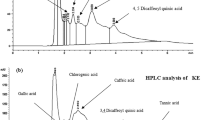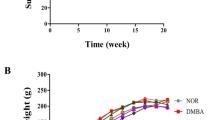Abstract
Cancer prevention and treatment using phytochemicals have attracted increased interest. Recent studies have shown that Semecarpus anacardium Linn nut milk extract (SA), a promising antioxidant and anticancer drug, exerts its anticancer effect through reducing or quenching reactive oxygen species under different conditions. The present study examined whether Phyllanthus emblica Linn fruit, rich in vitamin C content synergistically in combination can enhance both the antioxidant and anticancer activity of S. anacardium nut milk extract in 7, 12-dimethyl benz[a]anthracene (DMBA)-induced experimental mammary carcinoma in rat model. Female Sprague Dawley rats of 180 ± 10g were categorized into six groups. Three groups were administered DMBA (25mg/rat, orally) dissolved in olive oil to induce mammary carcinoma. One of these groups received Kalpaamruthaa (KA) (300mg/kg b.wt, orally) and other group received SA (200mg/kg b.wt, orally) for 14 days after 90 days of DMBA induction. A vehicle treated control and drug control groups were also included. The mitochondrial fraction of untreated DMBA-induced mammary gland showed 2.61-fold increase in lipid peroxidation level and abnormal changes in the activities/levels of mitochondrial enzymic (superoxide dismutase, glutathione peroxidase and glutathione reductase) and non-enzymic (glutathione, vitamin C and vitamin E) antioxidants were observed. DMBA treated rats also showed decline in the activities of mitochondrial enzymes such as succinate dehydrogenase, malate dehydrogenase, α-ketoglutarate dehydrogenase and isocitrate dehydrogenase. In contrast, rats treated with Kalpaamruthaa showed normal lipid peroxide level and antioxidant defenses. The results of the present study highlight the improved antioxidant property of KA than sole treatment of S. anacardium nut milk extract.
Similar content being viewed by others
References
Chopra R: The Indian scene. J Clin Oncol 19: 106S–111S, 2001
Cai Y, Luo Q, Sun M, Corke H: Antioxidant activity and phenolic compounds of 112 traditional Chinese medicinal plants associated with anticancer. Life Sci 74: 2157–2184, 2004
Premalatha B: Semecarpus anacardium Linn. nuts-a boon in alternative medicine. Indian J Exp Biol 38: 1177–1182, 2000
Arathi G, Sachdanandam P: Therapeutic effect of Semecarpus anacardium Linn. nut milk extract on carbohydrate metabolizing and mitochondrial TCA cycle and respiratory chain enzymes in mammary carcinoma rats. J Pharm Pharmacol 55: 1283–1290, 2003
Premalatha B, Sujatha V, Sachdanandam P: Modulating effect of Semecarpus anacardium Linn. nut extract on glucose metabolizing enzymes in aflatoxin B1-induced experimental hepatocellular carcinoma. Pharmacol Res 36: 187–192, 1997
Jose JK, Kuttan G, Kuttan R: Antitumour activity of Emblica officinalis. J Ethnopharmacol 75: 65–69, 2001
Khare CP: Encylopedia of Indian medicinal plants. Springer-verlag, Berlin Heidelberg, Germany, 2004, pp. 200–203
Sorata Y, Takahama U, Kimura M: Cooperation of quercetin with ascorbate in the protection of photosensitized lysis of human erythrocytes in the presence of hematoporphyrin. Photochem Photobiol 48: 195–199, 1988
Chen CY, Milbury PE, Kwak HK, Collins FW, Samuel P, Blumberg JB: Avenanthramides and phenolic acids from oats are bioavailable and act synergistically with vitamin C to enhance hamster and human LDL resistance to oxidation. J Nutr 134: 1459–1466, 2004
Satoh K, Ida Y, Ishihara M, Sakagami H: Interaction between sodium ascorbate and polyphenols. Anticancer Res 19: 4177–4186, 1999
Bhuvaneswari V, Velmurugan B, Abraham SK, Nagini S: Tomato and garlic by gavage modulate 7, 12-dimethylbenz[a]anthracene-induced genotoxicity and oxidative stress in mice. Braz J Med Biol Res 37: 1029–1034, 2004
Salet C, Moreno G: Photosensitization of mitochondria. Molecular and cellular aspects. J Photochem Photobiol B 5: 133–150, 1990
Esterbauer H: Estimation of peroxidative damage. Pathol Biol (Paris) 44: 25–28, 1996
Formulary of Siddha medicine. Published by the Indian medicine practioners Co-operative pharmacy and stores Ltd, Chennai, India, p 197, 1972
Senior AE, McGowan SE, Hilf R: A comparative study of inner membrane enzymes and transport systems in mitochondria from R3230AC mammary tumor and normal rat mammary gland. Cancer Res 35: 2061–2067, 1975
Hogberg J, Larson RE, Kristoferson A, Orrenius S: NADPH dependent reductase solubilized from microsomes by peroxidation and its activity. Biochem Biophys Res Commun 56: 836–842, 1974
Mehler AH, Kornberg A, Grisolia S, Ochoa S: The enzymatic mechanism of oxidation-reductions between malate or isocitrate and pyruvate. J Biol Chem 174: 961–977, 1948
Slater EC, Bonner WD: Succinate dehydrogenase. Biochem J 52: 185–96, 1952
King J: The dehydrogenases or oxidoreductases–lactacte dehydrogenase. In: D. Van (ed). Practical Clinical Enzymology. Nostrand Company Limited, London, pp 83–93, 1965
Reed LJ, Mukherjee BB: α-Ketoglutarate dehydrogenase complex from Escherichia coli. Methods Enzymol 13: 55–61, 1969
Marklund S, Marklund G: Involvement of the superoxide anion radical in the autoxidation of pyrogallol and a convenient assay for superoxide dismutase. Eur J Biochem 47: 469–474, 1974
Rotruck JT, Pope AL, Ganther HE, Swanson AB, Hafeman DG, Hoekstra WG: Selenium: Biochemical role as a component of glutathione peroxidase. Science 179: 588–590, 1973
Sinha AK: Colorimetric assays of catalase. Anal Biochem 47: 389–395, 1972.
Moron MS, Depierre JW, Mannervik B: Levels of glutathione, glutathione reductase and glutathione S-transferase activities in rat lung and liver. Biochim Biophys Acta 582: 67–78, 1979
Omaye ST, Turnbull JD, Sauberlich HE: Selected methods for the determination of ascorbic acid in animal cells, tissues, and fluids. Methods Enzymol 62: 3–11, 1979
Desai ID: Vitamin E analysis methods for animal tissues. Methods Enzymol 105: 138–147, 1984
Lowry OH, Rosebrough NJ, Farr AL, Randall RJ: Protein measurement with the folin phenol reagent. J Biol Chem 193: 265–275, 1951
Behrend L, Henderson G, Zwacka RM: Reactive oxygen species in oncogenic transformation. Biochem Soc Trans 31: 1441–1444, 2003
Szewezyk A, Wojtczak L: Mitochondria as a pharmacological target. Pharmacol Rev 54: 101–127, 2002
Hennipman A, van Oirschot BA, Smits J, Rijksen G, Staal GE: Glycolytic enzyme activities in breast cancer metastases. Tumour Biol 9: 241–248, 1988
Pedersen PL: Tumor mitochondria and the bioenergetics of cancer cells. Prog Exp Tumor Res 22: 190–274, 1978
Barber DA, Harris SR: Oxygen free radicals and antioxidants: a review. Am Pharm NS 34: 26–35, 1994
Vuokko L, Kinnula, Crapo JD: Superoxide dismutases in malignant cells and human tumors. Free Radic Biol Med 36: 718–744, 2004
Dean RT, Fu S, Stocker R, Davies MJ: Biochemistry and pathology of radical-mediated protein oxidation. Biochem 324: 1–18, 1997
Stahl W, Sies H: Antioxidant defense-vitamins E and C and carotenoids. Diabetes 46: S14–S18, 1997
Galati G, O'Brien PJ: Potential toxicity of flavonoids and other dietary phenolics: significance for their chemopreventive and anticancer properties. Free Radic Biol Med 37: 287–303, 2004
Williams RJ, Spencer JP, Rice-Evans C. Flavonoids: antioxidants or signalling molecules? Free Radic Biol Med 36: 838–849, 2004
Gowri BS, Platel K, Prakash J, Srinivasan K: Influence of amla fruits (Emblica officinalis) on the bio-availability of iron from staple cereals and pulses. Nutr Res 21: 1483–1492, 2001
Bhattacharya A, Chatterjee A, Ghosal S, Bhattacharya SK: Antioxidant activity of active tannoid principles of Emblica officinalis (Amla). Indian J Exp Biol 37: 676–680, 1999
Zhang Y, Abe T, Yang C, Kouno I: Phyllanemblinins A-F, new ellagitannins from Phyllanthus emblica. J Nat Prod 64: 1527–1532, 2001
Kim DO, Lee CY: Comprehensive study on vitamin C equivalent antioxidant capacity (VCEAC) of various polyphenolics in scavenging a free radical and its structural relationship. Crit Rev Food Sci Nutr 44: 253–273, 2004
Author information
Authors and Affiliations
Corresponding author
Rights and permissions
About this article
Cite this article
Arulkumaran, S., Ramprasath, V.R., Shanthi, P. et al. Restorative Effect of Kalpaamruthaa, an Indigenous Preparation, on Oxidative Damage in Mammary Gland Mitochondrial Fraction in Experimental Mammary Carcinoma. Mol Cell Biochem 291, 77–82 (2006). https://doi.org/10.1007/s11010-006-9199-2
Received:
Accepted:
Published:
Issue Date:
DOI: https://doi.org/10.1007/s11010-006-9199-2




